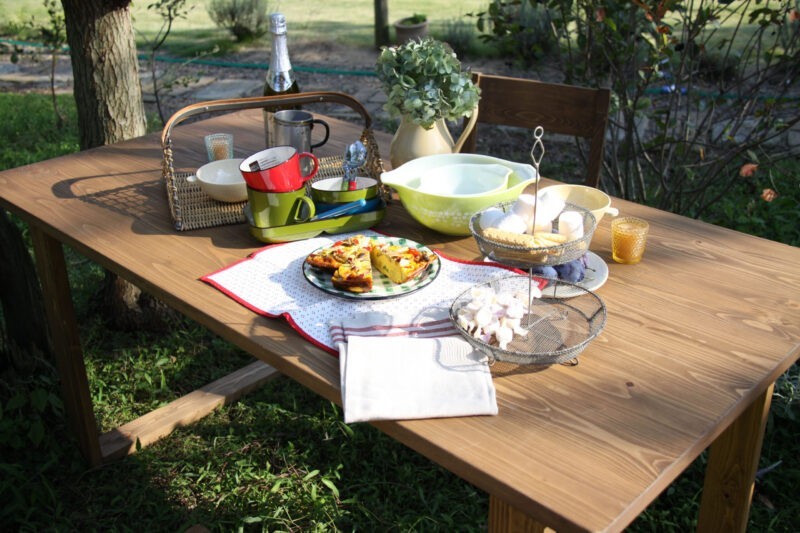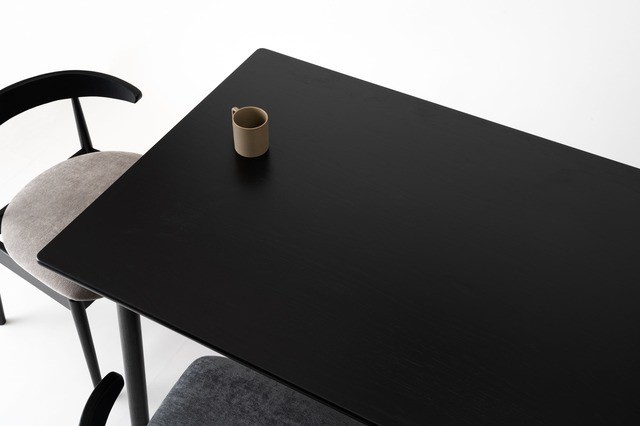In furniture production, wood is a crucial element. There are various types of wood, each with different characteristics and uses. In this article, we will delve into the types and characteristics of the major wood materials commonly used in furniture making.
The items sold at daus lab for furniture and interior design have their materials listed in the “Material” section of the product name or product page.
Hardwood and Softwood
Hardwood generally refers to the wood from deciduous trees, while softwood refers to wood from coniferous trees.
■Hardwood
Due to its durability and beauty, hardwood is utilized in a wide range of applications and is often esteemed as high-quality timber.

- Characteristics:
- Hardwood: Hardwood is derived from deciduous trees, known for their hardness and high density.
- Variety in Grain Patterns: Hardwood encompasses a wide range of tree species, resulting in diverse grain patterns and colors, making it ideal for beautiful furniture and construction materials.
- Durability: Generally, hardwoods have higher density and durability compared to softwoods. Therefore, they are used in high-quality products like furniture and flooring.
- Common Applications:
- Furniture Making: Hardwood is widely used in high-quality furniture production due to its beautiful grain patterns and durability. It is utilized in crafting tables, chairs, cabinets, and more.
- Flooring: Hardwood is a popular choice for flooring due to its durability and aesthetic appeal. It is often used in living rooms, bedrooms, and other areas where a durable and attractive floor covering is desired.
- Construction Materials: Hardwood is also utilized in construction as a building material. It is used for roofing, beams, exterior cladding, and other areas requiring durability.
- Woodworking: Hardwood finds extensive use in woodworking for crafting wooden decorations, crafts, sculptures, and more.
■Softwood
Softwood is widely utilized across various applications such as construction materials and the paper industry due to its lightweight and softness. Generally, it is more cost-effective compared to hardwood and is abundantly available.

- Characteristics:
- Derived from Coniferous Trees: Softwood comes from coniferous (evergreen) trees and is characterized by its relatively soft and lightweight nature.
- Simple Grain Patterns: Softwood typically exhibits simple grain patterns, featuring a more uniform texture compared to hardwood.
- Fast Growth: Coniferous trees generally have rapid growth rates, allowing for quick wood supply cycles.
- Common Applications:
- Construction Material: Softwood is widely used as a construction material, employed for structural elements such as pillars, beams, and roofing materials.
- Pulpwood: Softwood is a crucial material in the paper industry, serving as a source of wood pulp for manufacturing newspapers, packaging paper, and other paper products.
- Wood Products: Softwood is utilized in the production of furniture and wooden goods, including decking materials, fences, boards, and pallets.
- Woodworking: Softwood is suitable for DIY projects and woodworking due to its ease of processing, making it a popular choice for casual woodworking enthusiasts.
Hardwood
- Oak
- Oak is known for its durability, robust structure, and beautiful grain patterns. It is commonly used in a variety of furniture pieces and flooring due to these characteristics.
- Product Example: Oak Simple Modern Tripod Round Dining Table 110cm Form
- Oak is known for its durability, robust structure, and beautiful grain patterns. It is commonly used in a variety of furniture pieces and flooring due to these characteristics.
- Maple
- Maple is characterized by its light color and smooth texture, making it suitable for crafting furniture and cabinets.
- Walnut
- Walnut is renowned for its deep color and rich grain, making it an attractive choice for high-end furniture and cabinets.
- Product Example: Nordic Natural Dining Table with Walnut and Acacia Legs
- Walnut is renowned for its deep color and rich grain, making it an attractive choice for high-end furniture and cabinets.
- Cherry
- Cherry wood features a reddish-brown hue and smooth texture, making it popular for furniture, cabinets, and decorative items.
- Mahogany
- Mahogany is characterized by its warm reddish-brown hue and rich grain, making it a popular choice for high-end furniture and decorative items.
- Product Example: 4-Tier Mahogany Shoe Slipper Rack
- Mahogany is characterized by its warm reddish-brown hue and rich grain, making it a popular choice for high-end furniture and decorative items.
- Teak
- Teak is highly durable and resistant to water, making it suitable for outdoor furniture and decks on boats.
- Product Example: Industrial Side Table with Teak and Black Iron
- Teak is highly durable and resistant to water, making it suitable for outdoor furniture and decks on boats.
- Ash
- Ash is known for its hardness, durability, and light color with beautiful grain patterns. It is suitable for furniture and sports equipment.
- Product Example: Simple Modern Armchair with Ash and Paper Cord
- Ash is known for its hardness, durability, and light color with beautiful grain patterns. It is suitable for furniture and sports equipment.
- Beech
- Beech wood is hard, sturdy, and has a uniform texture. It is used in various furniture and craft items.
- Product Example: White High Stool with Beech and Steel
- Beech wood is hard, sturdy, and has a uniform texture. It is used in various furniture and craft items.
- Rubberwood
- Rubberwood is known as a sustainable material and is gaining attention in the modern era of SDGs. It has a soft hue and smooth texture, and is used in various furniture pieces. The name “Rubberwood” comes from the fact that it is derived from the central part of the Hevea rubber tree, which is used in rubber production.
- Product Example: Nordic Natural Rubberwood Desk
- Rubberwood is known as a sustainable material and is gaining attention in the modern era of SDGs. It has a soft hue and smooth texture, and is used in various furniture pieces. The name “Rubberwood” comes from the fact that it is derived from the central part of the Hevea rubber tree, which is used in rubber production.
- Mindii
- Mindii is known for its high durability and beautiful grain, making it a preferred choice for luxury furniture and decorative items. From the 18th to the 19th century, luxury furniture made from Mindii wood was favored among European nobility and the wealthy.
- Product Example: Vintage Dresser & Stool Set with Luxury Mindii Wood and Black Iron
- Mindii is known for its high durability and beautiful grain, making it a preferred choice for luxury furniture and decorative items. From the 18th to the 19th century, luxury furniture made from Mindii wood was favored among European nobility and the wealthy.
- Monkeypod
- Monkeypod is a wood known for its beautiful grain and durability, making it widely used in furniture making, decorative items, sculptures, and as a construction material.
- Product Example: Vintage Low Table Resembling a Monkeypod Stump
- Monkeypod is a wood known for its beautiful grain and durability, making it widely used in furniture making, decorative items, sculptures, and as a construction material.
- Acacia
- Acacia is known for its beautiful grain and durability, making it widely used for indoor and outdoor furniture as well as flooring materials.
- Product Example: Acacia Bench with Herringbone Pattern, 130cm Width
- Acacia is known for its beautiful grain and durability, making it widely used for indoor and outdoor furniture as well as flooring materials.
Softwood
- Pine
- Pine is soft, lightweight, and economical. It is widely used in furniture and construction materials.
- Product Example: Nordic Natural Pine Dining Table with Marble-like Stone Pattern
- Pine is soft, lightweight, and economical. It is widely used in furniture and construction materials.
- Cedar
- Cedar is highly durable and has insect-repellent properties, making it suitable for outdoor furniture and closets.
- Product Example: Cedar Flap Chest
- Cedar is highly durable and has insect-repellent properties, making it suitable for outdoor furniture and closets.
- Spruce
- Spruce is lightweight yet strong, making it suitable for musical instruments and construction materials.
- Fir
- Fir wood is known for its high strength and soft grain, making it suitable for various applications.
- Hemlock
- Hemlock is characterized by its uniform texture and smooth grain, making it suitable for use in construction materials and furniture.
Plywood and Pressed Wood
- Birch plywood
- Birch Plywood is robust yet lightweight, commonly used in many furniture and architectural applications.
- MDF(Medium-density fiberboard )
- MDF (Medium Density Fiberboard) is affordable and easy to work with, widely used in furniture manufacturing.
- Product Example: Simple Café Table with Glass Tabletop
- MDF (Medium Density Fiberboard) is affordable and easy to work with, widely used in furniture manufacturing.
- OSB (Oriented Strand Board)
- OSB (Oriented Strand Board) is known for its high strength and durability, commonly used in the manufacturing of walls, floors, and furniture.
- Product Example: OSB Stacking Box with Casters (Large)
- OSB (Oriented Strand Board) is known for its high strength and durability, commonly used in the manufacturing of walls, floors, and furniture.
- Veneer
- Veneer is thin sheets of wood used to decorate surfaces. It allows for the preservation of the natural beauty of real wood while keeping costs down.
- Product Example: Cool and Modern Black Iron Round Table
- Veneer is thin sheets of wood used to decorate surfaces. It allows for the preservation of the natural beauty of real wood while keeping costs down.
- Laminated veneer lumber
- Laminated veneer lumber is made by stacking thin layers of wood, providing strength and cost-effectiveness. It is widely used in furniture and construction applications.
- Product Example: Desk with Combination of Black Steel and Wood Grain
- Laminated veneer lumber is made by stacking thin layers of wood, providing strength and cost-effectiveness. It is widely used in furniture and construction applications.
Summary
Each type of wood has its own unique characteristics and is used for various purposes such as furniture making and construction. In furniture, both durability for the intended use and the decorative aspects of wood grain and color are important. Additionally, wood plays a significant role in interior design, greatly influencing the overall appearance.



